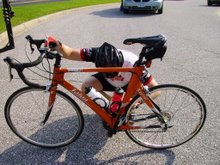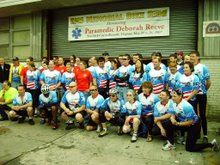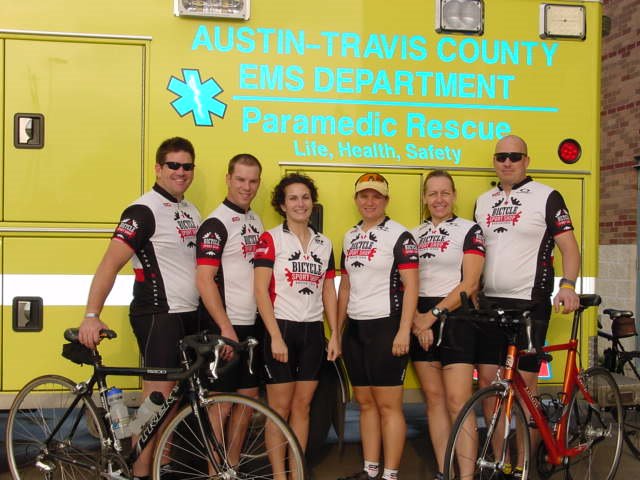Whether exercising indoors or outdoors, water replacement is one of the most important things a person can do to maintain energy levels and fitness gains, as well as speed recovery.
You have heard it before, but it bears repeating: by the time you feel thirsty, your body is already compromised by the effects dehydration. Becoming dehydrated will decrease your energy and performance and increase your recovery time. Uncorrected dehydration can lead to muscle cramps, nausea, dizziness and heat exhaustion.
Guidelines for staying well-hydrated:
Drink plenty of water before, during and after exercise. Weigh yourself before and after exercise. For every pound you lose, you should replace it with about 500cc (16 ounces of water). For indoor cycling, most cycling disciplines recommend 40 ounces of water for 40 minutes of work. Some experts believe that indoor cyclists sweat more than outdoor cyclists because there is not as more air movement to cool the body, therefore more heat production and more sweat. Outdoors, however, the air movement will tend to dry/evaporate the sweat, so you may not think you are sweating much at all. In reality you could be sweating as much or more as indoors. So, if you are both an indoors and outdoors cyclist, weighing yourself could be very beneficial.
If you are using energy drinks to assist with hydration, look for those with 7 percent carbohydrate or less. These will provide about the same hydration benefits as plain water. Sweetened juices, commercial sports drinks and sodas have a higher sugar content which will delay gastric emptying, therefore making them undesirable for hydration. Keep in mind that recovery drinks and mixes are higher in carbohydrates, but you will be using those post-workout.
Alcohol and caffeine are diuretics and should be avoided prior to a workout.
Urine should remain clear. Dark or cloudy urine tends to indicate dehydration. By the time you see this, you are probably behind the hydration schedule.
Cheryl Bakhtiari
Most gyms have a group indoor cycling program of some kind. Johnny G is probably the best known of these as he created the “spinning” program. Johnny G’s program is so well known that participants often refer to any and all indoor group cycling classes as “spinning” or “spin.” Other indoor group cycling programs are Precision Cycling, RPM, Schwinn, and Reebok to name a few. So what’s the difference? Not all that much. Most programs purport to mimic outdoor cycling and all tout their program as the best for various reasons. I started teaching group indoor cycling several years ago. I had taken one class when it was first introduced at my local gym in about 1992 and hated it. The class incorporated weights, resistance bands, and push-ups on the bike – crazy! I vowed I would never take another class. When I started teaching group fitness in 2001, however, my manager convinced me that I should teach group cycle. So against my better wishes and with many pre-conceived notions, I signed up. The instructor training was awesome and changed my mind completely. The whole concept of group indoor cycling had changed by that time and it really did feel like I could bring a little outdoors inside.
With all of that said, instructors vary greatly. When looking for a group indoor cycle class that works for you, you will need to ask yourself why you are going. Do you want to be entertained? Want to be in company during your misery? Want to get stronger? Improve your pedal stroke? Improve your cardiovascular capacity? Be indoors when it is too hot/cold/windy/rainy? Know why you are working out indoors to begin with. Try different classes/instructors until you find a good fit. We always recommend that you try a particular class at least three times before you make up your mind. Maybe that seems like a lot of work, but it is well worth it. Always bring a towel and water bottle to your class. Proper etiquette includes, wiping the bike down when you are done and raising the handlebars and seats. It also includes NOT carrying on a loud conversation with the person next to you. If you must answer your cell phone, take it out of the room. Try not to pass gas in class. If you have really strong BO when you sweat, take a shower before your class and use deodorant. Your instructor will not likely say anything to you if you violate one of these etiquette guidelines, but your fellow serious participants will have you tarred and feathered! If you have an issue, such as a knee problem and know you will not be able to do some of the drills, let the instructor know so they will understand that you are not ignoring them. If you know that you will have to leave early, also good to let the instructor know so that he/she won’t think you are leaving because you didn’t like the class. Finally, the instructor has the responsibility of bringing a class format that fits all fitness levels, but the bottom line is that it is your ride.
Cheryl Bakhtiari













































No comments:
Post a Comment